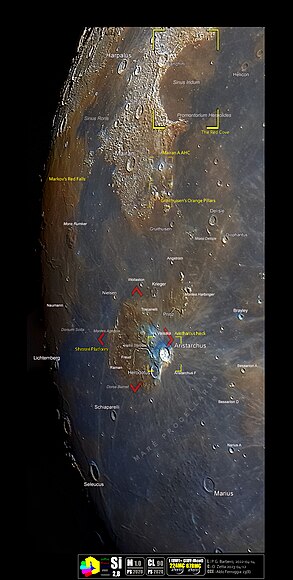| This article needs additional citations for verification. Please help improve this article by adding citations to reliable sources. Unsourced material may be challenged and removed. Find sources: "Sinus Iridum" – news · newspapers · books · scholar · JSTOR (June 2008) (Learn how and when to remove this message) |
 Annotated Sinus Iridum by LRO Annotated Sinus Iridum by LRO | |
| Coordinates | 45°01′N 31°40′W / 45.01°N 31.67°W / 45.01; -31.67 |
|---|---|
| Diameter | 249 km |
| Eponym | Bay of Rainbows |


Sinus Iridum /ˈsaɪnəs ˈɪrɪdəm/ (Latin sinus īridum "Bay of Rainbows") is a plain of basaltic lava that forms a northwestern extension to the Mare Imbrium on Earth's moon. It is surrounded from the northeast to the southwest by the Montes Jura range. The protruding part of the range at the southwest end is named Promontorium Heraclides, while that at the northeast end is called Promontorium Laplace. This bay and the surrounding mountains is considered one of the most beautiful features on the Moon, and is a favorite among lunar observers.
Sinus Iridum is formed from the remains of a large impact crater, which was subsequently flooded with basaltic lava, inundating the "sea" wall. The bay itself does not contain any notable impact craters, but does include the satellite crater Heraclides E in the south, Laplace A along the eastern edge, and Bianchini G in the north. The surface is level, but is marked by a number of wrinkle ridges (dorsa).
Sinus Iridum is one of the largest craters of Upper (Late) Imbrian age.
The selenographic coordinates of the bay's center are 45.01° N, 31.67° W, and the diameter is 249 km. It was the planned landing site of Chang'e 3, China's 2013 lunar exploration mission, which instead landed nearby in Mare Imbrium.
When 10 to 11 days after new moon the Sinus Iridum is still in shadow, the Montes Jura can already be visible at the lunar terminator. This geometry is also called Golden Handle.
Satellite craters
By convention these features are identified on lunar maps by placing the letter on the side of the crater midpoint that is closest to Promontorium Heraclides.
| Heraclides | Latitude | Longitude | Diameter |
|---|---|---|---|
| A | 40.9° N | 34.2° W | 6 km |
| E | 42.9° N | 32.7° W | 4 km |
| F | 38.5° N | 33.7° W | 3 km |
The following satellite craters are associated with the Promontorium Laplace.
| Laplace | Latitude | Longitude | Diameter |
|---|---|---|---|
| A | 43.7° N | 26.8° W | 9 km |
| B | 51.3° N | 19.8° W | 5 km |
| D | 47.3° N | 25.5° W | 11 km |
| E | 50.3° N | 19.8° W | 6 km |
| F | 45.6° N | 19.8° W | 6 km |
| L | 51.7° N | 21.0° W | 7 km |
| M | 52.2° N | 19.9° W | 6 km |
See also
References
- ^ "Gazetteer of Planetary Nomenclature - Sinus Iridum". United States Geological Survey. International Astronomical Union (IAU). 18 October 2010. Retrieved 2018-01-30.
- The geologic history of the Moon. USGS Professional Paper 1348. By Don E. Wilhelms, John F. McCauley, and Newell J. Trask. U.S. Government Printing Office, Washington: 1987. Table 11.2.
External links
- Wood, Chuck (2006-08-20). "Out the Porthole". Lunar Photo of the Day. Retrieved 2016-09-18., excellent earth-based image of Sinus Iridum and vicinity
- Nemiroff, R.; Bonnell, J., eds. (8 February 2008). "The Bay of Rainbows". Astronomy Picture of the Day. NASA.
- On the Shore of the Bay of Rainbows - Lunar Reconnaissance Orbiter page with images
- High resolution video by Seán Doran of an overflight of Sinus Iridum, based on LRO data; this video also passes over Sinus Iridum about halfway through (see album for more)
| Lunar maria | |
|---|---|
| Oceanus | |
| Mare | |
| Lacus | |
| Sinus | |
| Paludes | |